
| Home | Table of contents | Keys | Species list | Glossary | Image data | PDF | Cite this article | Feedback | Updates |
Identification Atlas of the Vespidae (Hymenoptera, Aculeata) of the northeastern Nearctic region
CJAI 05, February 19, 2008
doi: 10.3752/cjai.2008.05
Matthias Buck, Stephen A. Marshall, and David K.B. Cheung
Department of Environmental Biology, University of Guelph, Guelph, Ontario, Canada N1G 2W1
Next species | Previous species | Key
76. Polistes exclamans Viereck, 1906
Figs B1.13, 17; B10.6, 8, 10, 12, 45; C76.1–8.
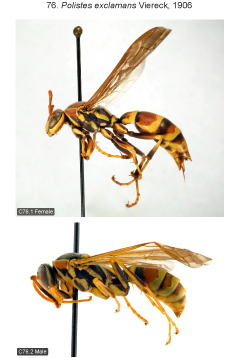 |
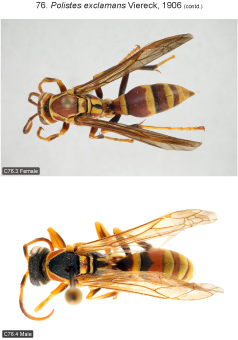 |
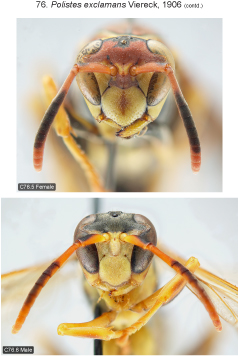 |
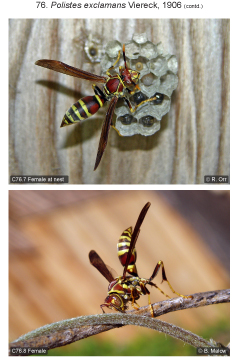 |
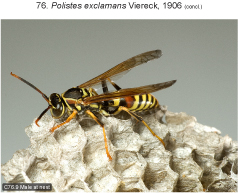 |
Species recognition. This species is unlikely to be confused with other species. It is the only species in the area covered by this work with a yellow spot on the lower mesopleuron (in front of the metapleural suture). All metasomal segments (except sternum 1 and rarely apical segments) have well-developed yellow apical fasciae and the propodeum has four yellow stripes. Both characters occur usually in P. dominula and very rarely in P. fuscatus, but the former lacks ferruginous markings on the body (present and usually extensive in P. exclamans), while in the latter the flagellum is more or less unicolorous dorsally (contrastingly coloured with dark median and bright orange apical flagellomeres in P. exclamans).
Variation. Fore wing length 13.0–16.5 mm (♀♀), 12.0–15.0 (♂♂). The extent of ferruginous markings is variable. They are present at least on the centre of the clypeus (female), most of frons (female, excluding black area around ocelli and yellow inner orbits), pronotal disc except ventrally, most of scutum, median portion of all terga (in male sometimes very reduced). In very light specimens black markings are largely replaced by ferruginous except for the following: part of occiput, some mesosomal sutures, limited areas of mesopleuron (behind scrobal furrow) and metapleuron (above pit), central groove of propodeum, narrow bases of terga 1–3, part of hind femur, mid and hind tibiae. Yellow markings are variable in size but quite constant in presence/absence. They may be present or absent on metapleuron and on terga 5 and 6 (female, according to Richards 1978).
Distribution. Canada: one record from ON (adventitious; 1 ♂, Weston, DEBU). Eastern U.S.: NJ, IN, IL south to FL, west to NE, CO, OK and TX, recently (by accidental introduction?) also in NM (Dona Ana Co., photographic record, Bugguide), AZ (1 ♀ from a nest, Bisbee, USNM) and CA (Orange Co., photographic record, Bugguide); introduced to HI. Mexico: Chihuahua to Jalisco, Hidalgo (Richards 1978, Carpenter 1996a).
Biology. Nests usually in sheltered places (e.g., eaves under roofs), also in trees. Males show territorial behaviour, a very unusual trait in social wasps (Richards 1978). Prey consists of caterpillars of various families including Arctiidae, Saturniidae, Hesperiidae, Notodontidae, Noctuidae, Erebidae, Pieridae, Crambidae (Pyraustinae) and Sphingidae (Krombein 1979).
Next species | Previous species | Key
| Home | Table of contents | Keys | Species list | Glossary | Image data | PDF | Cite this article | Feedback | Updates |
